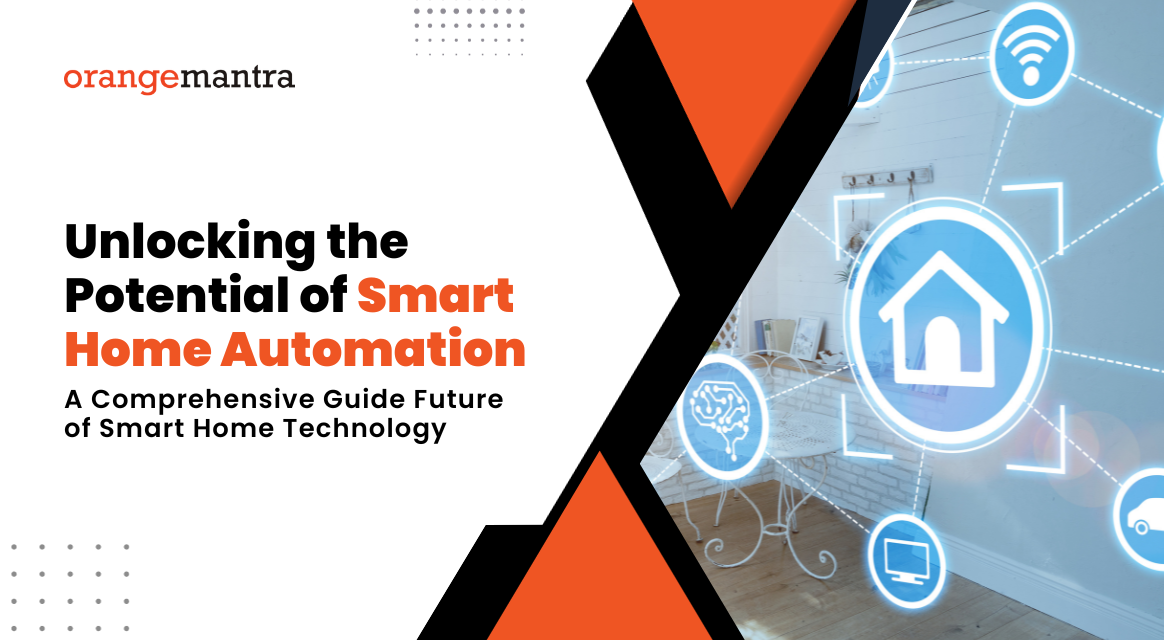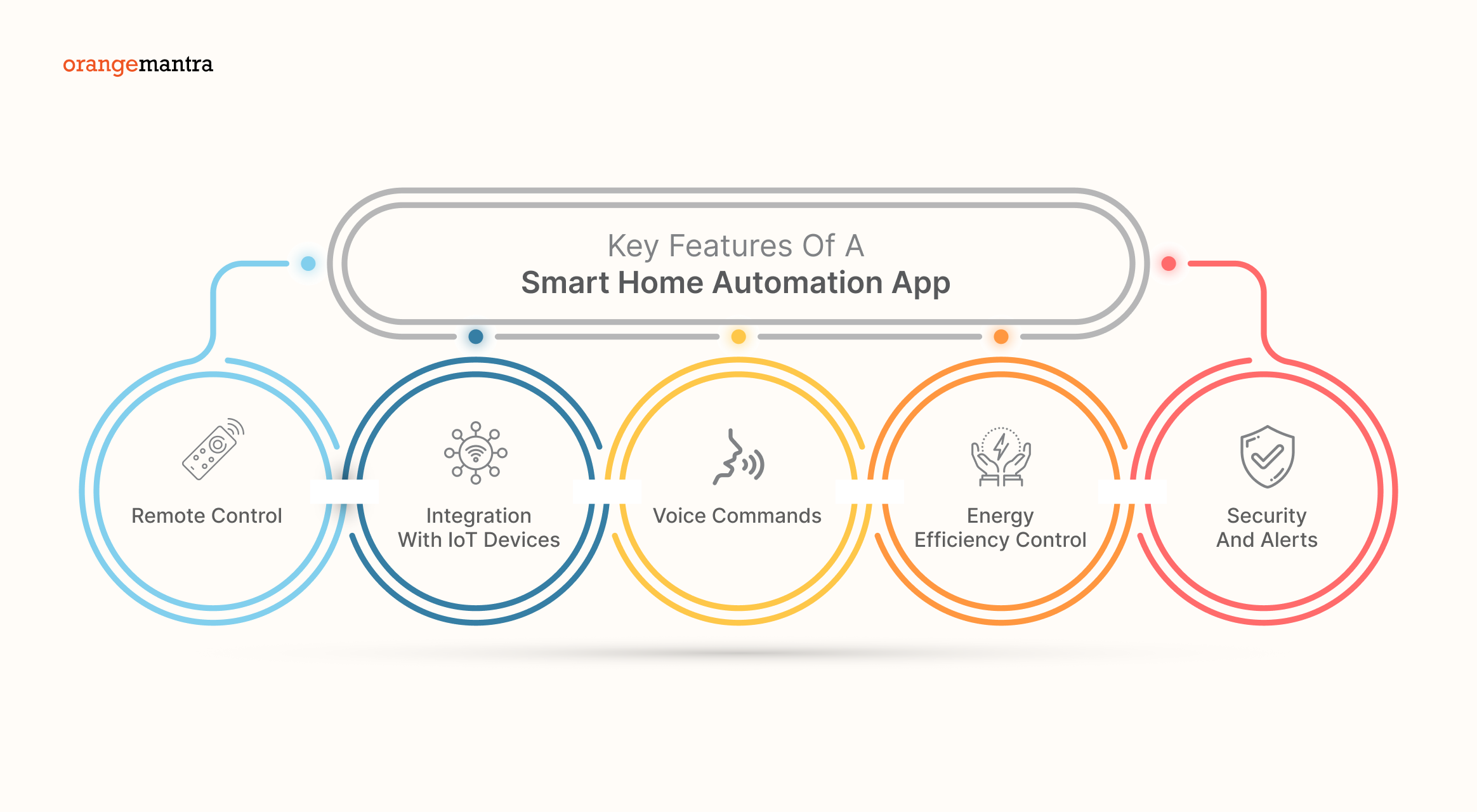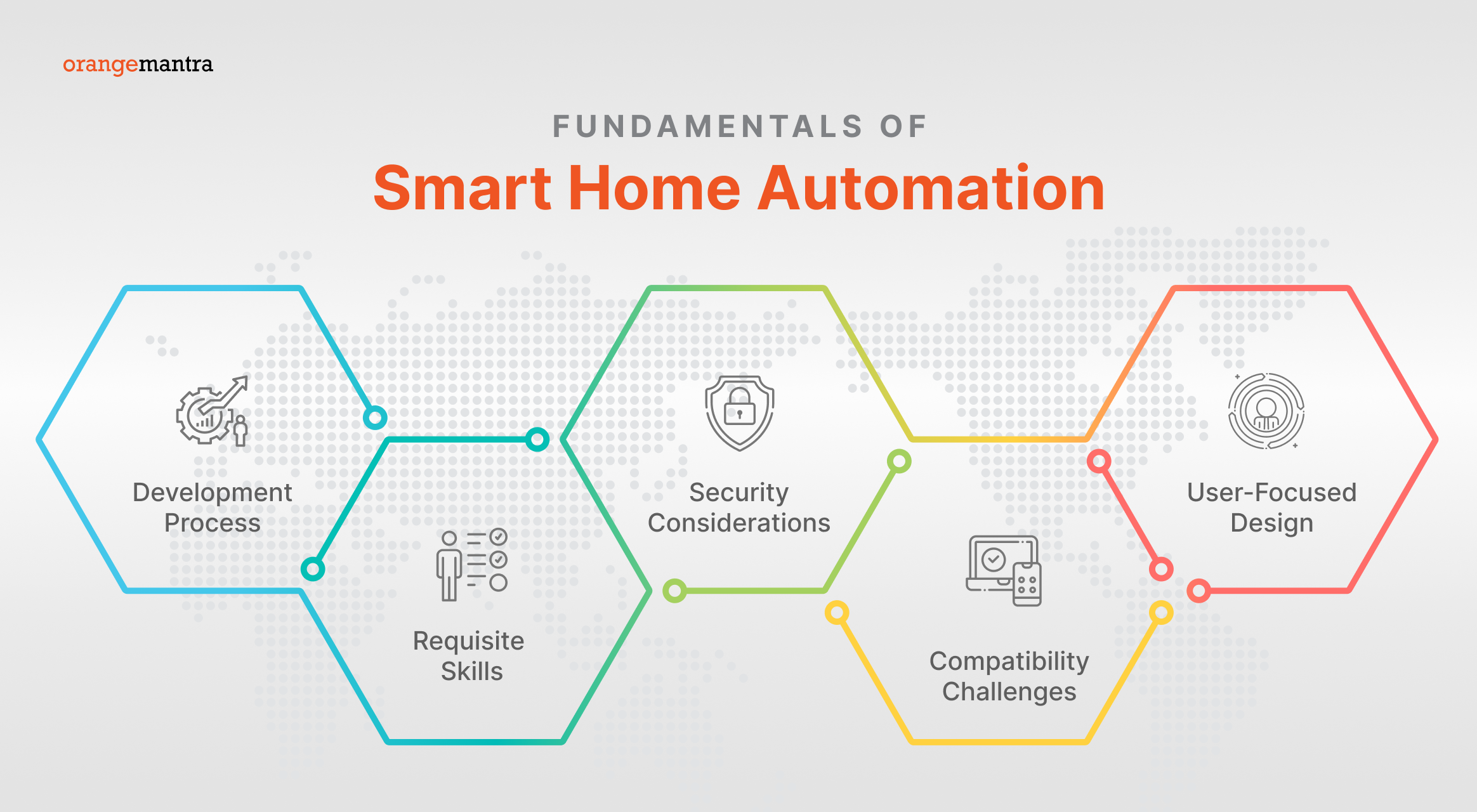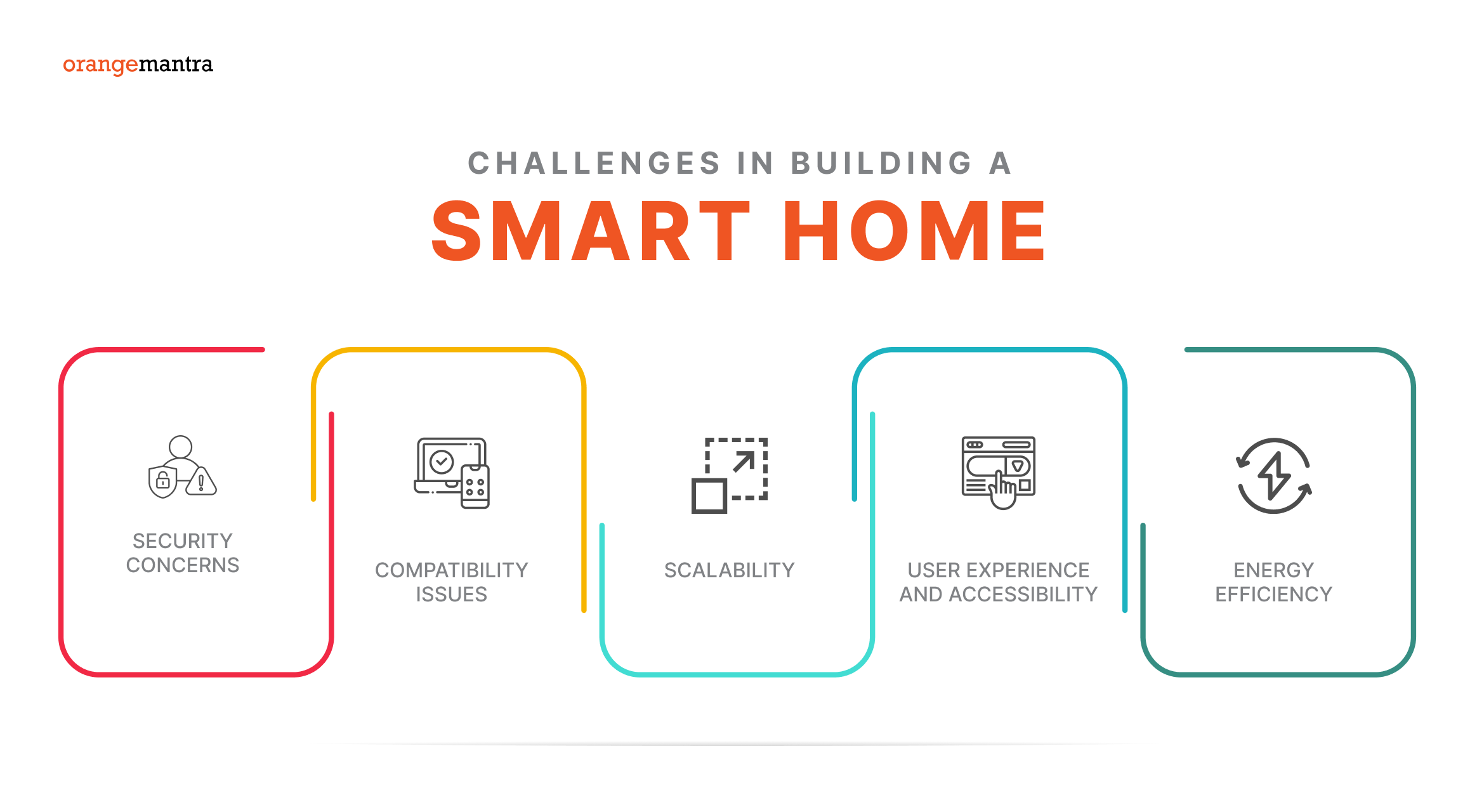
Here’s what you will learn:
In the digital age, our homes are evolving into intelligent living spaces. Thanks to the surge in Smart Home Automation, we now possess the capability to manage various aspects of our domestic environment effortlessly, all from our smartphones. This piece will delve into the realm of smart home automation applications, providing you with a thorough comprehension of what they constitute, their operational principles, and the challenges and prospects entailed in their development.
Table of Contents
Exploring the Core of Smart Home Automation
-
Automation: The Path to Ultimate Convenience
Smart home automation systems are not just a modern convenience; they’re a transformative leap into a future where technology takes on the mundane, leaving you with more time for what truly matters. By seamlessly handling routine activities, it elevates your lifestyle.
-
Integration of a Multitude of Devices
At the heart of smart home automation lies the integration of an impressive array of devices, each with its unique role. From lighting that adjusts to your mood to thermostats that adapt to your preferences, from security cameras that keep a vigilant eye to smart locks that secure your fortress, these devices form a cohesive ecosystem that operates harmoniously.
-
Efficiency and the Pursuit of Sustainable Living
Beyond convenience, smart home automation champions the cause of efficiency and sustainability. It aspires to elevate your home’s functionality while contributing to energy conservation. By optimizing energy use and reducing waste, it cultivates an environmentally conscious living environment, helping you make a difference one automated task at a time.
-
Seamless Remote Control and Monitoring
Imagine being in full control of your home, even when you’re miles away. Smart home automation apps makes this possible through intuitive mobile apps. Whether you’re at work, on vacation, or simply on the go, you can oversee and manage your home’s ecosystem effortlessly. Never worry about leaving lights on or forgetting to adjust the thermostat again.
-
Customization and the Ever-Evolving Future
Smart home systems cater to your unique needs, allowing extensive customization to suit your lifestyle. The world of smart home automation is dynamic, consistently embracing the latest technologies and innovations, ensuring your smart home remains an ever-improving marvel that adapts to your changing needs and tech advancements.
How Does It Function?
Smart home automation hinges on a sophisticated network of interconnected devices, frequently denoted as the Internet of Things (IoT). These devices encompass a wide range, from thermostats to security cameras, and maintain communication over the internet. Picture it as a meticulously orchestrated symphony, where each device plays its part in perfect harmony. This collaborative symphony creates an environment where convenience and efficiency intertwine seamlessly, allowing you to manage various aspects of your home with ease, no matter where you are.
Read Also – Top 5 Advantages of IoT for SMBs
Key Features of a Smart Home Automation App
A smart home automation app encompasses a myriad of features designed to augment your home’s functionality and overall convenience. Below, we outline the key elements that define these apps:
-
Remote Control
Smart home automation apps offer the remarkable capability to govern your devices remotely. Whether you find yourself at home or far away, you possess the power to make thermostat adjustments, illuminate or extinguish lights, and even scrutinize your security cameras, all through a few simple taps on your smartphone.
-
Integration with IoT Devices
These applications are meticulously crafted to integrate seamlessly with an extensive array of Internet of Things (IoT) devices. This ensures compatibility and versatility as you connect and manage diverse brands and types of smart appliances. The result is a harmonious and interconnected smart home ecosystem that caters to your needs.
-
Voice Commands
Voice commands stand as a ubiquitous feature within many smart home automation applications, granting users the ability to supervise their devices by utilizing voice assistants such as Amazon Alexa, Google Assistant, or Apple’s Siri. This hands-free approach markedly enriches the user experience, introducing an extra stratum of convenience into their daily lives.
-
Energy Efficiency Control
These smart home apps grant you the power to optimize energy consumption by configuring schedules for your devices. For instance, you can program your thermostat to regulate the temperature when you’re absent, leading to substantial cost savings and fostering a more environmentally conscious lifestyle.
-
Security and Alerts
The inclusion of real-time alerts and notifications serves to fortify your home’s security. You’ll promptly receive alerts in the event of unexpected activities, like motion sensors being triggered. Furthermore, many apps seamlessly integrate with your home security systems, affording both convenience and safety in a single, user-friendly interface.
Why Your Enterprise Needs Smart Home Automation Devices
Guess what? It’s not just the homes that are poised for a remarkable transition thanks to IoT-based Intelligent Automation Services. A traditional corporate environment will also enter a new era built on convenience, productivity, and eco-sustainability.
Here’s how smart office automation solutions can help turn boring offices into employee-centric workspaces:
Productivity skyrockets
Businesses in 2024 are always on the lookout for innovative ways to bump up their efficiency. Embracing automation can do just that while making the workplace more convenient and dynamic. With IoT-enabled Robotic Process Automation (RPA) Development Services, bots can be utilized to employees’ benefits, ensuring business continuity in case outsourced resources are knocked offline.
Save on electricity bill
It’s no secret that IoT-led smart offices can lower operating costs by an appreciable margin. It also helps lower maintenance expenses by notifying facilities about potential issues before they turn into big problems. Smart devices can delay cycles to off-peak hours, thus reducing energy consumption and preventing costly repairs caused by equipment failure.
Remote access
Automating your workplace can be oh so convenient; whether you’re operating heavy-duty machinery, engaging in team communication, or simply unwinding in the office cafeteria. Furthermore, IoT Powered Smart Warehouse Solutions enable remote access to smart desks, HVAC systems, etc. across multiple warehouse locations using a smartphone app. This helps improve workforce safety and space utilization throughout warehouses.
Leveled-up security
IoT-powered smart appliances have the potential to improve employee and asset security. By incorporating smart locks and surveillance systems into the office framework, remote monitoring and crisis response becomes a cinch. That way, IoT Smart App Development through AI can actively secure OT devices (CCTVs, doorbells, smart lights, etc.) that previously were easy targets for hackers.
Reduced carbon footprint
Digital technologies are touted to reduce emissions by 20% by 2050 amongst the 3 highest-emitting sectors: energy, automotive, and manufacturing. Smart office appliances will allow companies to monitor and better manage their energy consumption through remote monitoring. For instance, a digital transformation company proficient in IoT integration can install energy-efficient appliances to regularize air conditioning, thus reducing carbon footprint.
The Fundamentals of Smart Home Automation App Development
-
Development Process
Creating a smart home automation app entails a multifaceted development process. This encompasses app development, integration with IoT devices, and the crafting of a user-friendly interface. The collaboration of a diverse team comprising developers, designers, and IoT specialists is indispensable to yield a robust and seamless application.
-
Requisite Skills
Initiating the venture of constructing a smart home automation app necessitates a profusion of expertise in mobile app development, a profound grasp of IoT protocols, and the acumen to fashion an intuitive user experience. Developers should be adept at coding and programming the app, while designers should concentrate on formulating an enticing and user-friendly interface.
-
Security Considerations
Security assumes paramount importance when constructing a smart home automation app. Safeguarding user data and ensuring the security of connected devices is imperative. Developers must institute rigorous security measures to fortify against plausible vulnerabilities and breaches.
-
Compatibility Challenges
The abundant assortment of IoT devices procurable in the market can engender compatibility quandaries. Ensuring the app functions harmoniously with diverse brands and categories of smart appliances is pivotal to furnish users with a gratifying experience. Compatibility testing and uninterrupted updates are pivotal in mitigating these challenges.
-
User-Focused Design
A triumphant smart home automation app places user-centric design at its core. It ought to be effortless to employ, intuitive, and highly responsive. An iterative process of user feedback and testing should be ongoing to enhance the app’s interface and functionality in harmony with the evolving requisites and anticipations of users.
Challenges and Considerations in Building a Smart Home Automation App
1- Security Concerns: Safeguarding the Digital Fortress
In the world of smart home automation, security reigns supreme. Protecting user data and device security is an unwavering commitment, fraught with multifaceted considerations. Robust encryption techniques stand as the impregnable walls of our digital fortress, fortified by sophisticated user authentication mechanisms. However, the battle doesn’t end here. Continuous security updates are our sentinels, standing vigilant to address vulnerabilities and cyber threats that evolve in the ever-shifting landscape of technology.
2- Compatibility Issues: The Puzzle of Harmony
The smart home ecosystem is a symphony of diverse IoT devices, each playing its unique tune. Yet, this diversity introduces a puzzle of compatibility. The integration with various brands and protocols is not a choice but a necessity, requiring intricate orchestration. Compatibility testing becomes our conductor’s baton, orchestrating a harmonious user experience, ensuring that every device plays in sync within the grand composition of your smart home.
3- Scalability: The Ever-Expanding Canvas
A smart home is not static; it’s an ever-evolving masterpiece. The app must adapt to the dynamic expansion of smart home ecosystems, akin to an artist’s canvas expanding with each stroke. Designing for scalability is our palette of colors, preventing performance issues as the system grows and ensuring that the painting of your smart home remains vivid and lifelike.
4- User Experience and Accessibility: The Heart of Interaction
The user interface is the heart of the smart home automation app, the portal through which users interact with their digital domain. It’s a labyrinth where simplicity is key, and an intuitive, user-friendly interface is the guiding light, making the journey through the realm of smart devices effortless and enjoyable. Inclusivity is our mantra, with support for voice commands and accessibility features, ensuring that every user, regardless of ability, can participate in the symphony of smart living. Furthermore, the user’s experience is enriched with customization options, allowing them to sculpt their smart home into a personalized masterpiece.
5- Energy Efficiency: Prolonging the Digital Symphony
In the era of battery-operated IoT devices, energy efficiency is the secret to sustaining the digital symphony. Optimizing energy usage is not just a consideration but a critical mission. Efficient coding practices, the magic of background processing, and the adoption of low-energy communication protocols are our tools to orchestrate this mission. The grand finale is extended battery life for devices, ensuring that the digital symphony of your smart home never faces an abrupt silence, always ready to play on.
Read Also – AR and VR app development companies Reshaping the Future in Healthcare
Opportunities and Market Trends
1- Escalating Demand: The Emergence of Essentiality
Smart home automation has transcended its status as a mere luxury; it has evolved into a necessity propelled by the surging desire for convenience, energy efficiency, and security. This paradigm shift from novelty to a pervasive trend has unveiled a plethora of prospects for developers and enterprises. As individuals aspire to streamline their daily routines and elevate their living spaces, the smart home sector finds itself on the brink of a transformative phase, brimming with opportunities for substantial growth and innovation.
2- Market Competition: The Battle for Dominance
The smart home automation market is a battlefield where tech giants and innovative startups engage in fierce competition. Success in this dynamic arena hinges on differentiation through unique features, outstanding user experiences, and exceptional customer support. With a myriad of players in the field, the competitive landscape is not for the faint-hearted. Businesses must continuously innovate to capture and retain their market share.
3- Market Segmentation: Nurturing Niche Markets
The diverse landscape of consumer segments presents a mosaic of needs, desires, and preferences. Smart businesses understand that one size doesn’t fit all. Tailoring solutions to niche markets, such as home security, energy management, or health and wellness, can be a strategic masterstroke. By addressing the specific requirements of these segments, companies can create tailored experiences that resonate deeply with their target audience.
4- Integration with Other Services: Expanding the Horizon
Smart home apps hold the potential to create added value by integrating with other services, such as home security and energy providers. These seamless integrations amplify the user experience, offering comprehensive solutions that go beyond mere automation. The synergy between smart home technology and related services empowers users with a holistic approach to managing their homes, increasing the market’s attractiveness and driving further demand.
5- Emerging Technologies: The Catalyst for Transformation
The smart home automation landscape is continuously reshaped by emerging technologies, including AI, machine learning, and IoT. These cutting-edge innovations enable a new era of intelligence and predictive automation, significantly enhancing the user experience and device connectivity. With AI-driven insights, machine learning algorithms, and the expansive reach of IoT, smart homes become smarter, more efficient, and more attuned to their inhabitants’ needs. As these technologies mature, the industry will see unprecedented growth and evolution.
Smart Home App Comparison: Alexa vs. Google Home vs. Apple HomeKit
In the rapidly evolving smart home automation landscape, selecting the ideal ecosystem is paramount. Amazon’s Alexa, Google Home, and Apple HomeKit are three prominent smart home platforms, each offering distinct features and capabilities. This comprehensive comparison aims to assist you in making an informed decision:
1. Voice Assistants:
Alexa: Amazon’s Alexa is renowned for its robust voice recognition and extensive compatibility with third-party devices. It empowers users to control their entire smart home through voice commands, with the Echo series serving as the primary interface.
Google Home: Google Assistant is the driving force behind the Google Home ecosystem, leveraging Google’s search and knowledge base for highly accurate responses. Google Home devices, such as Google Nest, seamlessly integrate with Google’s wider ecosystem, including Gmail and Google Calendar.
Apple HomeKit: At the heart of HomeKit is Siri, Apple’s voice assistant, celebrated for its natural language processing and deep iOS device integration. HomeKit provides a secure and private platform for smart device control, ensuring data stays within the Apple ecosystem.
2. Device Compatibility:
Alexa: Alexa’s broad compatibility extends to a wide range of third-party devices, covering everything from lights and thermostats to household appliances and entertainment systems, providing users with a diverse selection of choices.
Google Home: Google Home also extends its support to numerous third-party devices, emphasizing seamless integration with Google services. This makes it a robust option for those already immersed in the Google app ecosystem.
Apple HomeKit: Renowned for its stringent security standards, HomeKit may impose constraints on device compatibility. However, it compensates by offering a controlled and secure environment, particularly attractive to Apple users who prioritize data privacy and security.
3. User Experience:
Alexa: The Alexa app is user-friendly, with an intuitive interface for device control and management, catering to those seeking a hassle-free experience.
Google Home: Google Home delivers a seamless experience for users deeply embedded in the Google ecosystem, offering high personalization and context-aware interactions.
Apple HomeKit: Integrated into the iOS Home app, HomeKit offers an excellent user experience for Apple device users, known for its simplicity and user-friendliness.
4. Privacy and Security:
Alexa: Amazon has faced privacy scrutiny but has implemented measures to enhance security, allowing users to review and delete voice recordings and offering two-factor authentication.
Google Home: Google has introduced privacy features, enabling data review and deletion, along with two-factor authentication. However, concerns about data collection persist for some users.
Apple HomeKit: Apple is renowned for strict privacy policies, with HomeKit encrypting data locally and keeping personal information on the user’s iOS device, avoiding data collection for advertising purposes.
5. Cost:
Alexa: Amazon provides a range of devices, including budget-friendly options like the Echo Dot, with costs varying based on device features.
Google Home: Google offers devices at different price points, allowing users to align their choices with their budget and requirements.
Apple HomeKit: HomeKit’s cost is intertwined with the broader Apple ecosystem, which includes iOS devices and HomeKit-enabled products. While it may be perceived as relatively higher-priced, it offers a seamless experience for Apple users.
In conclusion, the selection among Alexa, Google Home, and Apple HomeKit hinges on your preferences and priorities. Alexa offers broad compatibility and ease of use. Google Home excels in integration with Google services and personalization. Apple HomeKit prioritizes privacy and security, catering to those within the Apple ecosystem. Assess your needs, existing devices, and privacy concerns meticulously to identify the best fit for your smart home.
Smart Home Automation on a Budget
-
Prioritize Essential Devices: Maximizing Value
Commencing your budget-friendly expedition into the realm of smart homes involves a crucial initial phase: pinpointing the indispensable smart devices that harmonize with your unique requirements and way of life. This strategic approach ensures that you obtain the utmost benefit from your investment. Prioritize devices that deliver substantial convenience or energy efficiency advantages. Ponder upon smart thermostats that adeptly manage your home’s temperature, intelligent lighting systems that contribute to reduced energy consumption, and security cameras that instill a sense of tranquility. Concentrating on these fundamental elements not only enriches your daily existence but also optimizes the return on your investment.
-
DIY Solutions: The Power of Self-Installation
Adopt the do-it-yourself mindset when dealing with smart home technology. Numerous smart devices are purposefully crafted for straightforward self-installation, and choosing the DIY route can substantially reduce your setup expenses. Seek out devices that include precise setup instructions, guaranteeing that you can establish your smart home effortlessly without the necessity of professional installation. This not only results in cost savings but also instills a sense of achievement as you take charge of configuring your devices independently.
-
Affordable Brands and Alternatives: The Smart Shopper’s Approach
A key aspect of building a smart home on a budget is to do your homework. Research and consider more budget-friendly brands and alternatives. While popular, well-known brands often come with a premium price tag, lesser-known brands frequently offer similar functionality at a lower cost. Be sure to read reviews and check for compatibility with your chosen ecosystem, ensuring that you’re not compromising on quality while saving on expenses.
-
Multi-Function Devices: Doing More with Less
To optimize both efficiency and cost-effectiveness, explore smart devices with multifunctional capabilities. For instance, certain smart speakers can also act as hubs, allowing them to control various other smart devices. This approach can effectively reduce the quantity of individual devices you need to buy. By combining functions within a single device, you not only lower your initial expenses but also streamline the management of your smart home, rendering it more user-friendly.
-
Automation Over Time: The Gradual Expansion Approach
Creating a budget-friendly smart home doesn’t require purchasing all the devices in one go. Instead, a wise approach is to begin with a few essential devices and gradually expand over time. This method allows you to spread out your costs and construct a comprehensive smart home according to your budget’s capacity. It’s a step-by-step process that enables you to prioritize your requirements and make informed choices at each stage. As you accumulate more devices, your smart home will naturally evolve, aligning with your financial means.
In conclusion, creating a budget-friendly smart home is not just about saving money; it’s about being strategic and thoughtful in your choices. By prioritizing, embracing DIY solutions, exploring affordable brands, seeking multi-function devices, and expanding gradually, you can build a smart home that enhances your life without breaking the bank.
The Future of Smart Home Technology: What to Expect
-
Increased Automation: The Age of Intuitive Homes
Smart home technology is about to usher in a new era of more automation. The development of intelligent technology will make it more perceptive, capable of understanding and foreseeing user preferences. This level of sophistication will empower homes to adapt seamlessly to the needs and habits of their residents. Imagine a home that optimizes energy use, fine-tunes comfort settings, and enhances security by learning and responding to the unique rhythms of your daily life. Whether it’s adjusting lighting to your liking or regulating the thermostat based on your preferences, automation will redefine convenience and efficiency.
-
Enhanced AI Integration: The Rise of Smart Assistants
AI development solutions will stand at the forefront of the smart home revolution. AI-powered smart assistants will take center stage, becoming more sophisticated and offering proactive assistance and advanced problem-solving capabilities. These assistants will seamlessly integrate with a wide range of smart devices, transcending mere voice commands to provide context-aware and anticipatory support. From managing your schedule to suggesting energy-saving practices, AI integration will make smart homes even more user-friendly, personalized, and efficient.
-
Improved Energy Efficiency: A Greener Tomorrow
Smart home technology remains steadfast in its dedication to enhancing energy efficiency. This commitment encompasses various advancements, including intelligent heating and cooling systems that adjust to your preferences and comprehensive energy monitoring that empowers you to make informed decisions about resource usage. Additionally, the integration of renewable energy sources will become increasingly prominent, rendering homes not only environmentally friendly but also more economical to operate. As environmental awareness expands, energy-efficient smart homes will assume a crucial role in promoting sustainability for the future.
-
Interconnectivity and Compatibility: Building a Unified Smart Ecosystem
The future holds the promise of increased interconnectivity among smart devices and improved compatibility between different brands and ecosystems. This will significantly reduce the fragmentation currently experienced by users, making it easier to build comprehensive smart home ecosystems. Imagine seamlessly connecting devices from various manufacturers and having them work harmoniously under a single unified interface. This trend will not only enhance user convenience but also encourage the adoption of smart home technology on a broader scale.
-
Emerging Technologies: Pioneering Innovations
In the future, the development of smart houses will heavily rely on contemporary technology like 5G, augmented reality, and virtual reality. These revolutionary discoveries will fundamentally alter how we interact with our living surroundings in the context of smart homes through creative applications. Empowered by the capabilities of 5G, remote monitoring will achieve an even higher level of seamlessness and responsiveness. AR and VR will usher in immersive experiences, enabling you to visualize and tailor your home environment in entirely novel and unprecedented ways. These technologies will unveil fresh opportunities for the management and interaction with your smart home, creating a reality where the boundaries between the physical and digital aspects of living seamlessly merge.
Conclusion
In conclusion, developing a smart home automation app is a challenging yet highly rewarding endeavor. It opens the door to unparalleled convenience, enabling users to control their homes remotely, but it also brings forth complex challenges, particularly in terms of security and compatibility. As we look to the future, the landscape of smart homes holds great promise for even more seamless and intelligent living spaces.
In this evolving trajectory, we anticipate heightened automation, where smart homes become increasingly intuitive and adaptive to residents’ needs. Advanced integration of artificial intelligence will propel these systems to anticipate and fulfill user preferences. Energy efficiency will take a central role, mitigating carbon footprints and fostering a more sustainable world. The enhanced interconnection of devices will simplify user experiences, and the advent of technologies like 5G, augmented reality, and virtual reality will revolutionize our interactions with our residences. The voyage of innovation persists in molding our way of life, heralding a future filled with excitement and transformation for homeowners.
FAQs
-
What benefits can you gain from embracing a smart home automation app?
Leveraging a smart home automation app offers you a multitude of advantages, chiefly among them is the unrivaled convenience it affords. Through your smartphone, you gain the power to remotely manage various facets of your home, encompassing lighting, climate control, and security, ensuring a seamless and efficient living environment.
-
Are smart home automation apps compatible with all types of smart devices?
Compatibility can vary, but many of these apps are designed to work with a wide range of IoT devices. It’s essential to check for compatibility with your specific devices and brands.
-
How can I ensure the security of my smart home automation app?
To enhance security, ensure your app employs robust encryption, user authentication mechanisms, and receives regular security updates. It’s also advisable to change default passwords and enable two-factor authentication when available.
-
What should I consider when building a smart home on a budget?
When budget-conscious, prioritize essential devices, opt for DIY solutions, consider budget-friendly brands, explore multi-function devices, and build your smart home gradually over time.
-
What advancements should we anticipate in the future of smart home technology?
In the foreseeable future, we can expect increased automation, enhanced integration of AI, improved energy efficiency, better interconnectivity and compatibility among devices, and the integration of emerging technologies like 5G and augmented reality.
-
How IoT app development enhance smart automation capabilities?
IoT app development is crucial in smart home automation, allowing seamless integration and control of devices. These apps offer features like voice commands, real-time alerts, and energy efficiency controls, enhancing functionality and convenience. Our curated smart office automation solutions ensure intuitive, secure, and compatible home automation systems with a wide range of IoT devices.
-
How does IoT contribute to curbing energy consumption in households.
IoT enhances smart homes by enabling homeowners to monitor and control their energy consumption. This happens by scheduling smart heating, cooling, and lighting appliances to automatically turn on/off as necessary. They also provide insights into energy consumption patterns, carbon footprint, etc. That way, homes and businesses can leverage intelligent automation services to create a sustainable living space.





